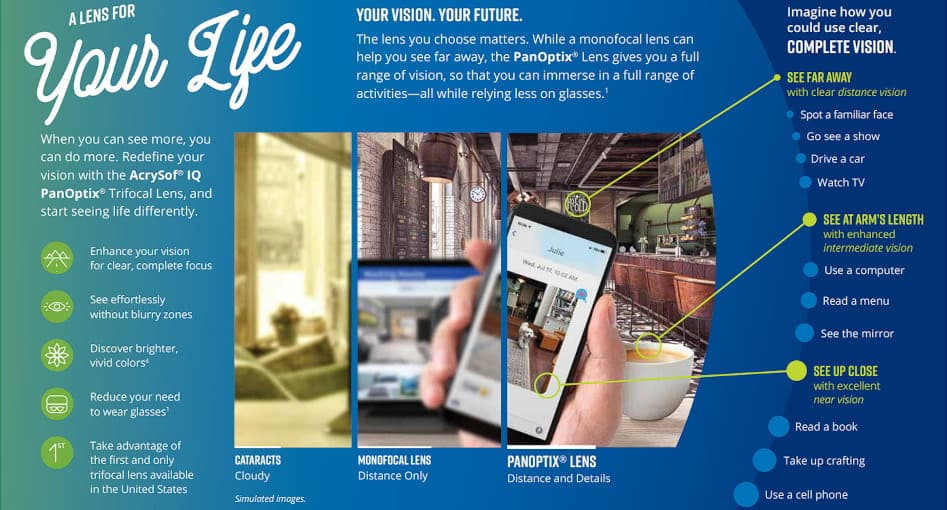Cataract Surgery Lens Options
LEARN ABOUT THE NEWEST IOL OPTION FROM SNEAD EYE GROUP
HAVE YOU BEEN TOLD YOU HAVE CATARACTS?
TYPES OF LENSES
When considering cataract surgery, it is important to understand your lens implant options, so you can choose a lens that best matches your lifestyle.
MULTIFOCAL LENSES
Presbyopia, the Greek word for “aging eye,” is a condition that causes near vision to decrease as we age, making it difficult to see things up-close. Presbyopia is the most prevalent eye condition in America, affecting most people after the age of 40 and nearly everyone by their early 50s. While some lenses are used to see clearly at a distance after cataract surgery, multifocal and accommodating lenses are specially designed to combat the effects of presbyopia for clear distance vision plus a full range of intermediate and near vision, reducing the need for corrective lenses or even reading glasses. Multifocal lenses are for the individual who desires the least amount of dependency on glasses and for busy people on the go, they are often referred to as the best of the best.
If you interested in being virtually free of reading glasses or bifocals, these advanced lenses are FDA approved and and give patients clear vision at all distances—near, intermediate, and far! While there are many different name brands, such as the Acrysof IQ ReSTOR IOL or the Tecnis® Multifocal IOL. These lenses are implanted during cataract surgery to replace the natural lens, which has become clouded by cataracts. These new lens can provide enhanced visual quality and the full range of vision, giving patients an increased independence from reading glasses and bifocals.
REMEMBER
Some eyes take longer than others to grow accustomed to multifocal lenses. The potential exists for problems with halos and glare (particularly at night). However, such problems have been limited and usually improve over time. Patients experiencing these difficulties still tend to experience better vision than they did prior to cataract surgery.
When considering cataract surgery, it is important to consider surgeons and surgery centers that offers several implant options and can discuss which options best match your lifestyle. Our surgeons perform thousands of cataract surgeries every year and are dedicated to offering the most advanced technology available.
TORIC LENSES
Toric or astigmatic lenses are for individuals who desire better distance vision and the correction of their astigmatism. Astigmatism is when the eye is longer, or shaped like a football rather than a basketball. As light rays are prevented from meeting at a common focal point, images become distorted. Astigmatism is quite common and can be corrected with intraocular lenses and limbal relaxing incisions performed with the LenSx laser during cataract surgery
MONOFOCAL
Monofocal, or standard lens implants focus at one main point that can be set at distance, intermediate or near based on your individual needs. This implant allows for the sharpest possible vision at its set point – usually distance. Since the monofocal lens is typically set to focus at distance, reading glasses or bifocals are often necessary to give patients the best possible near vision. Our standard monofocal lenses are the most advanced in their category, designed for distance and improving image quality.
CATARACT SURGERY USING SELF-SEALING INCISION AND TOPICAL ANESTHESIA
Topical anesthesia and self-sealing incisions are additional improvements that have taken cataract surgery to the next level. Many patients are able to see with clear vision much sooner after the surgery than years ago. In most cases it is now possible to return to daily activities such as driving and reading almost immediately.
Sometimes after cataract surgery, the back or posterior part of the lens capsule, or lens covering, becomes cloudy or opacified. This cloudiness is usually caused by cells growing onto the back of the capsule, causing blurred vision, glare or light sensitivity. Although not a true cataract, it is often referred to as a “secondary cataract”. This procedure is done as an outpatient procedure that does not require anesthesia. It is perfectly normal and can be removed by a quick and simple laser procedure.
SERVICES
